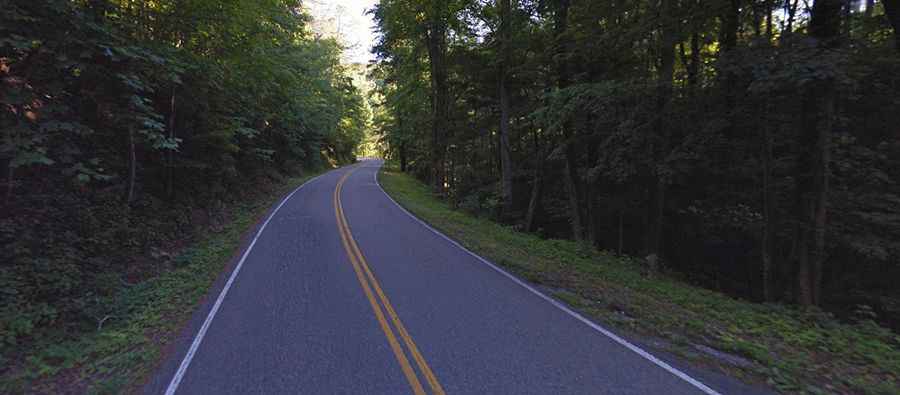The winding Tail of the Dragon in North Carolina: 318 curves in 11 miles
Straddling Tennessee and North Carolina in the USA, Deals Gap, also known as Tail of the Dragon, is one of the most scenic drives in the USA. Featuring 318 curves, this winding mountain road is unlike anywhere else in the world.

How many curves are on the Tail of the Dragon?
Part of US 129, this stretch of a two-lane road has become a hugely popular destination for motorcyclists and sports car drivers. The road features 318 curves in just 11 miles. It's best to be cautious as the turns are tight. Anyone looking for an exciting highway will enjoy this drive. It mostly travels through a forested area, and there are a few scenic overlooks and pull-off points along the route. With hundreds of blind curves, long blind crests, and high degrees of camber, this claustrophobic scenic forest road presents plenty of opportunities to leave the pavement both laterally and longitudinally, providing a challenge for even the most seasoned sim veterans.
Why is it called Tail of the Dragon?
The road earned its name from its curves being said to resemble a dragon's tail. Some of the Dragon's sharpest curves have names like Copperhead Corner, Hog Pen Bend, Wheelie Hell, Shade Tree Corner, Mud Corner, Sunset Corner, Gravity Cavity, Beginner's End, and Brake or Bust Bend. While you're there, be sure to visit the Tree of Shame, where crashed motorcycle bits adorn the tree and dangle from its branches as a reminder of the road's dangers.
Where does the Tail of the Dragon start and end?
The road is totally paved. It's 19.15 km (11.9 miles) long, running from the intersection of NC 28 and US 129 (in North Carolina) to the Tabcat Creek Bridge (in Tennessee). It is not a road for the squeamish, but if you're looking for a little excitement, don't miss this one.
Interestingly, within the same state of Tennessee, specifically in Cocke County, lies another very scenic and challenging drive known as Tennessee Route 32 South. Nicknamed the "Redneck Dragon," many drivers and riders who have experienced both roads believe Route 32 South, with its own hundreds of tight turns and steep gradients, can be even more demanding than the famed Tail of the Dragon.
Where was The Fugitive filmed?
It has been the setting for countless movies (in the Cheoah Dam, Harrison Ford jumped in the movie The Fugitive...) and advertisements.
When to drive the Tail of the Dragon?
Weather on the Dragon is fairly predictable most of the summer. The winter months from November through March can be impossible to predict. The road is desolate and can be a real adventure in the winter months, dealing with bears, turkeys, deer, and wild boars in the road, trees down, ice/snow, and tractor-trailers taking up both lanes in the curves. There are many ridable days in the winter, but they are not predictable. Higher elevations of the Cherohala and Blue Ridge Parkway can experience snow well into May. Many summer afternoons bring widely scattered rain showers. Often, the weather stations and web weather will indicate rain for the entire area. Be aware that you can still have nearly a full day of riding before the summer showers hit in mid-afternoon. And these showers are here and there... not everywhere. They often dissipate in the late afternoon, leaving several hours of good riding before dark. Cars can run the Dragon most of the year. Winter is a great time to have the road to yourself. At times, the road is dusted with salt/sand, but that is only when a severe storm is coming. It is usually gone after the next good rain. One big advantage of winter on the Dragon is the ability to see through many of the corners because the trees have dropped their leaves. Good visibility from November through March. One downside is the sun is lower and can get in your eyes even at noon. The shadows also make for reduced visibility.
Is it safe to drive the Tail of the Dragon?
The road is certainly breathtaking and has a fearsome reputation, but it is also one of the most exciting routes to ride. Tucked away between the Great Smoky Mountains National Park and Cherokee National Forest, the road attracts around 250,000 bikers each year. Tennessee and North Carolina have banned 18-wheelers from this highway. This road used to be a popular shortcut for truckers when I-40 was blocked by a landslide (which tends to happen once in a while). After so many accidents and incidents involving semi-tractors, the authorities finally decided to restrict large commercial vehicles from using this stretch a few years ago.